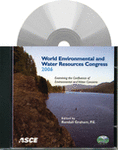Riparian Buffer Zone Change Detection Based on RADARSAT-1 and LANDSAT Satellite Images
Publication: World Environmental and Water Resource Congress 2006: Examining the Confluence of Environmental and Water Concerns
Abstract
A combination of RADARSAT-1 and Landsat 5 TM satellite images linking the soil moisture variation with Normalized Difference Vegetation Index (NDVI) measurements were used to accomplish remotely sensed change detection of riparian buffer zone in the Choke Canyon Reservoir Watershed (CCRW), South Texas. The CCRW was selected as the study area contributing to the reservoir, which is mostly agricultural and range land in a semi-arid coastal environment. This makes the study significant due to the interception capability of non-point source impact within the riparian buffer zone. First of all, an estimation of soil moisture using RADARSAT-1 Synthetic Aperture Radar (SAR) satellite imagery was conducted. With its all-weather capability, the RADARSAT-1 is a promising tool for measuring the surface soil moisture over seasons. The time constraint is almost negligible since the RADARSAT-1 is able to capture surface soil moisture over a large area in a matter of seconds, if the area is within its swath. RADARSAT-1 images presented at here were captured in two acquisitions, including April and September 2004. With the aid of five corner reflectors deployed by Alaska Satellite Facility (ASF), essential radiometric and geometric calibrations were performed to improve the accuracy of the SAR imagery. The horizontal errors were reduced from initially 560 meter down to less than 5 meter at the best try. Then two Landsat 5 TM satellite images were summarized based on its NDVI. The SAR data obviously show that soil moisture and vegetation biomass wholly varies in space and time in the CCRW leading to identify the riparian buffer zone evolution over seasons. It is found that the seasonal soil moisture variation is highly toed with the NDVI values and the change detection of buffer zone is technically feasible. Future research focuses on comparison of soil moisture variability within RADARSAT-1 footprints against NDVI variations for studying riparian ecosystem functioning on a seasonal basis. It will contribute to develop more effective management strategies for non-point source pollution control, bird habitat monitoring, and grazing and live stock handlings in the future.
Get full access to this chapter
View all available purchase options and get full access to this chapter.
Information & Authors
Information
Published In
Copyright
© 2006 American Society of Civil Engineers.
History
Published online: Apr 26, 2012
ASCE Technical Topics:
- Aerial photography
- Canyons
- Climates
- Ecosystems
- Engineering fundamentals
- Environmental engineering
- Equipment and machinery
- Geology
- Geomatics
- Geomechanics
- Geotechnical engineering
- Hydraulic engineering
- Hydraulic structures
- Measurement (by type)
- Radar
- Reservoirs
- Seasonal variations
- Sensors and sensing
- Soil mechanics
- Soil properties
- Soil water
- Surveying methods
- Vegetation
- Water and water resources
Authors
Metrics & Citations
Metrics
Citations
Download citation
If you have the appropriate software installed, you can download article citation data to the citation manager of your choice. Simply select your manager software from the list below and click Download.
